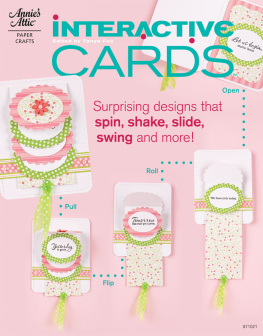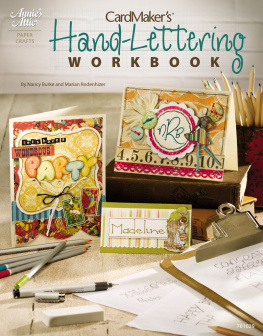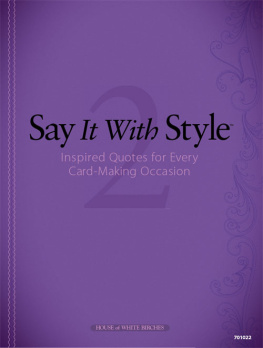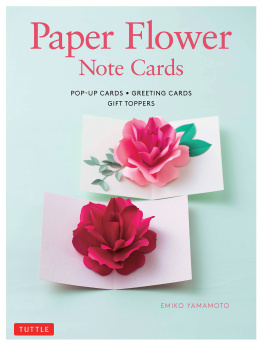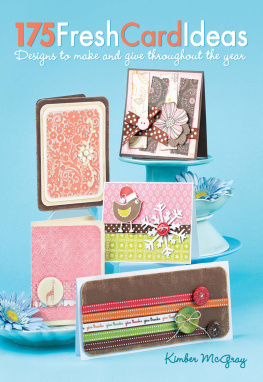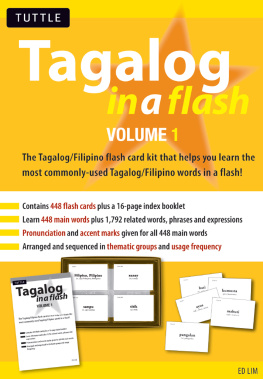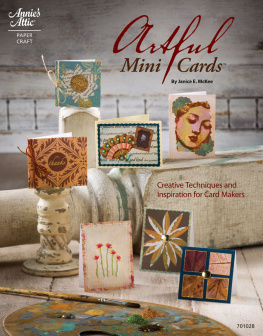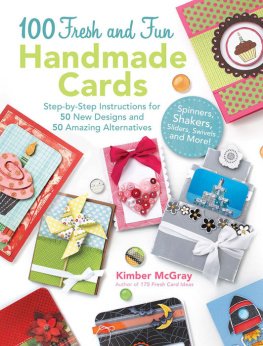
THE CARDMAKERS
workbook
The Complete Guide to Design, Color,
and Construction Techniques for Beautiful Cards
Jenn Mason

I like opening a letter and thinking myself loved.
Virginia Woolf

Contents

Introduction
The design principles used to create great cards are not exclusive to these small works of creativitythey are relevant to all types of art. Collage artists, painters, interior designers, cake decorators, and graphic designers all use composition, balance, color, construction, and a variety of techniques in their work. And they are all interested in new tools to help them design. Good design is achieved by translating or reinterpreting an idea, concept, or visual trigger in a unique and graphically pleasing way. When I teach a workshop, I tell my students that its not as important to take away the project were making as it is to be inspired by the creative process and the design principles theyre learning, so they can take this knowledge home and use it to make something new and different.
This workbook is divided into chapters that will walk you through the process of seeing composition, colors, and supplies in new ways. My goal, as I made card after card (after card), was to create a book that inspired each reader in a different way. If you are new to cardmaking, this book can help you discover a new world of creativity. If youre an old pro, this book can help you explore new ways of looking at colors, construction, and supplies and re-energize your creativity when you find yourself in a rut.
is for the penny pincher in all of us and offers ideas on how to stretch your supplies by using them in different ways for varied outcomes.
I havent forgotten those long hours of working on holiday cards. In covers the ins and outs of card making, with instructions for creating envelopes from scratch and lining them. It also includes an extensive list of sentiments for your cards.
This book is not just about the basics of design, it is a tool to point you in the direction of untold creativity. Use it as your diving board, then get on your swimsuit and bathing cap and dive in!
Jenn Mason
Tools & Techniques
You dont need much to make a card. You can create one with nothing more than a piece of paper, a stamp or embellishment, and a little time. This isnt to say that you couldnt take advantage of the wide range of supplies available at paper and craft storesquite the contrary. In very little time, and with a lot of money, you can easily amass (or should I say collect?) numerous card making tools, accessories, and embellishments, from very affordable eyelets (see ).
I cant possibly describe all the items you might possibly use in card making, but I can cover some basics and give you a brief primer on a few techniquessetting those eyelets, for example, and using rubber stamps.
First, the Supplies
Every good card maker has paper and something to cut, glue, and decorate it with. So, thats where well start.
PAPER IT
The number one rule here is, You get what you pay for. Inferior paper makes inferior cards. Two basic types of paper are used in card making: cardstock and decorative paper, which you can find in solid colors or printed with a design. What should you buy? Whatever makes your heart sing! If you havent traveled down the scrapbook aisles at the craft store lately, treat yourself to a trip. The number of papers available has exploded. And heres a tip: Scrapbook manufacturers introduce new paper lines as often as every six months, so youll always find new designs to feed your paper addiction.
CUT IT
Unless youve purchased a pack of blank cards, you will need to cut your paper. I suggest buying a paper trimmer with a small, replaceable cutting blade that slides back and forth to cut the paper. A number of companies make these; if youre not sure which one to choose, talk to creative friends and ask them for recommendations. (And dont forget to buy extra blades!) If you dont want to use a paper trimmer, you can always resort to the old standbys: the metal edge ruler, cutting mat, and craft blade.
I also keep a nice, sharp pair of small detail scissors on my work table. These are not expensive, so dont get them from the dollar store; they will dull too quickly. A good pair of scissors can slice through ribbon like buttah.
Another great cutting tool, when used correctly, is a pair of decorative edge scissors. There are many different blades, but you will be well served with pinking shears, scalloped, and deckle edge styles.
GLUE IT
For adhering bulky items onto a card, quick-dry tacky glue is my best friend. The acid-free glue stick, another of my adhesives of choice, is especially useful for adhering small and oddly shaped items. When I want to work quickly, I use an adhesive runner that lays down a film of adhesive in no time. And, finally, if I want to add dimension, I adhere elements with adhesive foam tape, dots, or squares.
DECORATE IT
The list of items that you can add to cards is endless, but here is a good start: stickers, rub-ons, brads, eyelets, staples, ribbons, waxed twine, tags, wire, binder clips, glitter, gel pens, decorative paper clips, and chipboard embellishments.
CREATE IT
This section wouldnt be complete without a list of the tools needed to create the endless variations of cards in this book. Keep in mind that collecting supplies and tools is addictive! The tools I like to use include an awl, stamps and inks, embossing powders and a heat gun, paper punches, die cut tools, sponge daubers, corner rounders, a Design Runner (a portable personal printer made by Xyron), eyelet setters (eyelets are useless without them!), hole punches (, , and 1/16 will do, a bone folder (for making great folds), black Micron pens, and a good ruler.
Second, the Techniques
FOLDING PAPER
Paper folds better in one direction than the other. To test this, lightly hold your chosen piece of paper in front of you, with one hand on each side.
Bring your hands toward each other, letting the paper bend in the middle, and note the resistance.
Rotate the paper 90 degrees, and repeat the test, again noting the papers resistance to bending.
Now, hold the paper in front of you in the direction that provides the least resistanceyoull find that the grain of the paper is vertical. (To remember this, you can draw a light arrow in pencil on the paper.)
When you cut the paper, you want the fold to be parallel to the grain of the paper. If youve ever folded a card and created a fold that was jagged or uneven, it was because you folded against the grain. If you must fold against the grain, score the paper first. You can use the scoring tool that comes with the paper trimmer, or you can create a score by simply tracing the fold line using the edge of a bone folder and a ruler. Either way, once youve folded your paper, go back over the fold with the bone folder to get a really crisp fold.
Next page

